
Bulletin 8 (IV:2), 1966
Home
Français
Introduction
History
Annual Index
Author &
Subject
Credits
Contact
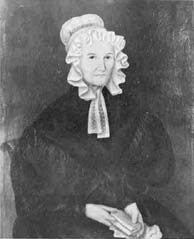
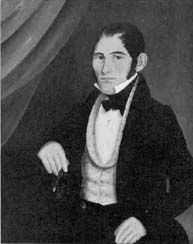
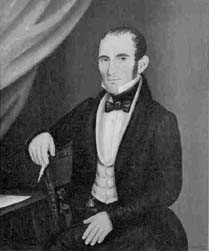
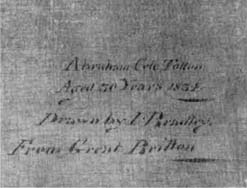
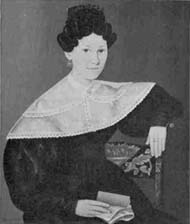
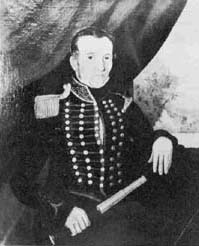
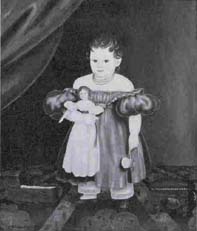
'Drawn by I. Bradley
From Great Britton'
by Mary Childs Black, Director
Museum of Early American Folk Art, New York
and Stuart P. Feld, Associate
Curator
of American Paintings and Sculpture
The Metropolitan Museum of Art, New York
Pages 1 | 2 |
3 | 4
As with Bradley's other subjects, it is difficult to
tell whether he went to the Coles or they to him. It is tempting
to think that the painter lived on Staten Island before establishing himself
in New York City in 1836, but seven months later, in December 1833, he
painted portraits of the New York merchant Simon Content and his wife Angelina
Pike Content {Figs. 4 & 5).
According to the New York City directories of the period, Content
was a dry goods merchant who conducted his business at three different
Grand Street locations between 1830 and 1840. Little more is known about
the Contents, but Bradley has effectively told us that they were of different
faiths. Mrs Content holds the Anglican Book of Common Prayer, while her
husband sits at a table on which is opened a copy of the Hebrew Old Testament.
On the right-hand page is visible a passage in Hebrew and on the facing
page its English translation: 'Able sais / ye obey the Command, / ments of
the Lord your / God which / commend you this day.'
The portraits of the Contents are striking paintings, with Content
shown in a high top hat and his wife in an elaborately embroidered and ruffled bertha and
bonnet. The compositions are closely related to those of the Cole portraits,
with Mrs Content being shown in exactly the same pose as Mrs Cole, but
in reverse.
Bradley showed a marked propensity to sign, date and inscribe
his works. Both Content portraits are signed I. Bradley and dated on the
front. In addition, an inscription on the back of the relined portrait
of Simon Content is apparently a careful copy of the legend on the original
canvas: 'Simon Content/Taken in the year 1833 Dec. / A Native from
Holland / NewYork / America...[illegible].' 'The identification of New York
as an American city is the first hint that the artist himself may have been a newcomer.
Six months later, in June 1834, five members of the Totten
family of Staten Island sat to Bradley: John Totten. his wife Ann Cole
Totten (Figs. 6 & 7), two of their 12 children, John (Fig. 8) and Abraham
Cole (Fig. 9), and Abraham's wife Mary Ann Brackett Totten (Fig. 10). All
but the portrait of the younger John are signed and dated on the front.
and all bear lengthy inscriptions on the back giving the names and ages
of the subjects. Evidence that Bradley had indeed newly arrived here is
firmly provided by a second signature on each, 'Drawn by I. Bradley / From
Great Britton' (Fig. 9a).
Mrs John Totten, dressed in a sombre black dress and white bonnet
befitting her age, holds a red book, while her husband rests his hand on
a table covered with a green baize cloth. Spots of brilliant red and green
are similarly introduced into the portraits of Abraham Cole Totten and
his wife. The red of Mrs Totten's book is echoed in the curtain behind
her husband who, like his father, is seated next to a table with a green
cover. The portraits are enriched with amusing bits of still-life detail.
The elder Totten holds a pair of calipers, and on the table at his side
is an inkstand with quill pen and other objects that defy identification.
His son Abraham Cole holds a syringe, while young John, who is posed in
almost the same way, holds a lighted cigar. All five Tottens are seated
in painted and stencilled Hitchcock-type chairs, which are particularly
noticeable in the portraits of Abraham Cole Totten and his wife. Bradley's peculiar
mannerism of outlining faces and hands with a white line, which gives them
a strangely luminous quality, is particularly noticeable in the portraits
in this group.
In 1834 Bradley painted two other Staten Island subjects, members
of the Ellis family, probably Alice Murray Ellis and her husband Abraham
Ellis, who later became Sheriff of Richmond County. The paintings are in
poor condition and have been almost completely over-painted so that only traces
of Bradley's work remain. Mrs Ellis, who faces to the viewer's right, wears
a black dress and a white collar and bonnet; she sits with her hand over
the arm of what appears to be an Empire-style sofa, upholstered in black
horse-hair with brass nails and a gilded rosette on the arm. Her husband
wears a dark coat with brass buttons and a black stock; like the younger John
Totten, who was painted in the same year, he holds a lighted cigar in one
hand. In the background of each is the same red curtain that is seen in
a number of Bradley's portraits.
The year 1835 is a vacuum in Bradley's
career, for no portraits from that year have come to light. By 1836 he
was listed in the New York City Directory as a 'portrait painter' at 56
Hammersley Street. Three portraits have been discovered that date to that
year. One of them is an intriguing and powerful likeness of a man in a military
uniform (Fig. 11). The subject has been identified as Mr Newton of Newton
Hook, New York, a small community in the township of Stuyvesant, a hundred
miles north of New York City on the east bank of the Hudson. Because we know so
little about Bradley's habits as a painter, it is impossible to tell at
this time whether he travelled up the Hudson or whether his sitter came to
New York. It was not unusual in the 1830's for a portrait painter to take
to the road looking for commissions, but there is little evidence that
Bradley ever went very far a field in search of subjects. Mr Newton is shown
seated in a typical Bradley pose with his left hand resting on the back
of his chair. Behind him is the familiar red curtain, which partially covers
a window through which is seen a vivid landscape- a unique detail in
Bradley's work. The view shows a skirmish between Indians and ranks of
American troops on a high cliff covered with palm trees on the shores of
a body of water. The scene may portray an incident in the Seminole
Wars. The first Seminole War lasted from 1815 to 1819; after a period of peace, the war was revived in November 1835 and was in progress
at the time the portrait was painted. Mr Newton's militia uniform, with
one epaulet and a single wing visible, is more in keeping with the period
of the first of the Seminole Wars, but there is no reason why he could
not have served in the second. The length of the fringe on the epaulet
indicates that he had achieved field grade of major or above. Another portrait
signed 'I. Bradley' and dated 1836 is Girl with Doll, the first of a group of
four full-length portraits of children (Fig.12). The subject, a child
of about four years, has not been identified. She stands on an elaborate
woven carpet or painted floor cloth of the type popular in the 1830's.
A beautifully-grained doll's cradle and a footstool with acorn feet
are shown along with the red curtain.
Next Page | Archaic
'J. Bradley'
1 | 2 |
3 | 4
Annual Index | Author & Subject | Credits | Contact
This digital collection
was produced under contract to Canada's Digital Collections program,
Industry Canada.
"Digital
Collections Program, Copyright
© National Gallery of
Canada 2001"